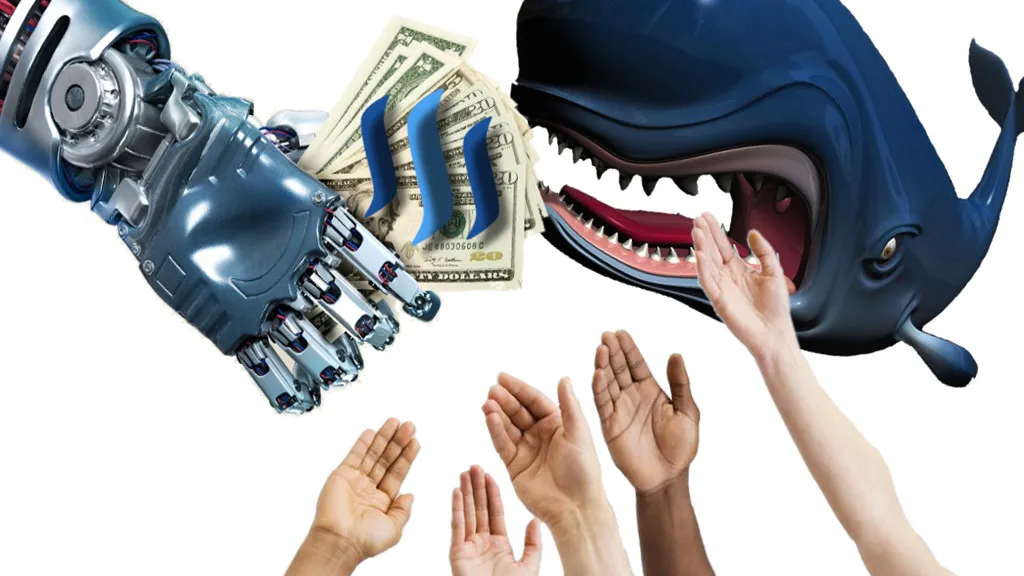
There’s a lot of contention on Steemit lately about the use of upvote bots.
At first, I personally stayed away from them as I found it distasteful to “pay myself” for my own content. That seemed antithetical to the nature of Steemit. Just like most people, I was under the impression that the primary intentions of Steem Inc. when making the Steem blockchain, was to enable bloggers and content creators to finally make the money they deserve. I was also under the impression that “free market forces” were the driving factor in determining content quality. Although this is essentially correct, I was wrong about one thing: the order of the priorities and intentions behind the Steem blockchain.
First and foremost, it’s important to understand that Steem Inc., Steemit.com, and the Steem blockchain are intrinsically capitalistic by design.
In the Steem White Paper Introduction on page 5 we read:
There are some key principles that have been used to guide the design of Steem. The most important principle is that everyone who contributes to a venture should receive pro-rata ownership, payment or debt from the venture. This principle is the same principle that is applied to all startups as they allocate shares at founding and during subsequent funding rounds.
(Italics mine)
What’s being said here is simple: The more money you invest the better you will do on Steemit.
This is why the basic cryptocurrency unit of the Steem blockchain is called a “Vest”, not “Steem”. Investments, private ownership, debt, venture, startups, and funding rounds, are all capitalistic concepts. Let me explain.

Most people who come to Steemit think they are at the open market.
The idea being that you have brought a product (your high quality content) to the market in hopes of trading it for Steem. You assume that your content has a value before arriving at the market, and that the “free and open Steemit market” will use the powers of “market choice” to determine the exact value of your content. You then hope to in turn use your hard earned Steem to purchase other goods or services.
| Product | → | Money | → | Product |
|---|---|---|---|---|
| (Quality blog content) | → | (Steem) | → | (Other goods and services) |
This flow diagram shows how an open market works. This is not capitalism. It’s just an open market.
Capitalism’s primary concept is that money can make more money.
A starting capital investment can create a new product that in turn makes more money then the initial startup cost. The flow diagram for capitalism looks like this:
| Money | → | Product | → | More Money |
|---|---|---|---|---|
| (Initial starting investment) | → | (A blog of some sort) | → | (More Steem added to your investment) |

The Bots Act Like An Automated Marketing Team
So, you put some starting capital into Steemit.com to get some Steem Power, which is nothing more than your ability to market your new “blog product”. Just like any venture capital startup, you need to grow your business or investors will not be happy (you will not be happy). You came here to make money, right? Like any innovative startup company, you have a top-notch marketing team that will promote your product and drive up sales. And that’s what the upvote bots do for you; they drive up “sales”. And at a fixed rate that actually earns. They help promote your content AND pay you back a little bit. Nice!
Bots Are Not What You Expect. Let’s Do The Math.
Regardless of the bot you use, you will be lucky to get a 300% upvote. More likely you will get 250%, which is what I found the average to be. So let’s say you pay an upvote bot 1 SBD, and in return you get a $2.5 STU upvote. Hey, pretty good, right? Not quite. Only 75% of that is yours, the rest goes to curation. So you get $1.875. However, that’s not 1.875 SBD, that’s 1.875 STU (Steem Token Units), which is split 50/50 into SBD and Steem Power. So that’s a return of 0.9375 SBD to the 1 SBD you paid. You just lost 0.0625 SBD. What about that Steem Power? Well that’s not 0.9375 Steem Power either. That’s $0.9375 USD worth of Steem Power, which of course depends on the current market price of Steem. As of this writing the price of Steem is currently at $3.21 USD. That means that’s an earning of 0.292056 Steem Power. If we were to magically convert that back into SBD without having to go through the 104 week power down process (at the time of this writing 1 SBD costs 1.02 SP which is nearly equal) we can say we earned a total of 1.23 SBD for the 1 SBD spent, but the earnings have gone straight to Steem Power, and are therefore not liquid, not something you can walk away with, not going to be a daily paycheck.

So How Are Others Making Money With Upvote Bots?
A post that gets upvoted gets seen more. It doesn’t matter if a real person or a bot did the upvoting. Enough upvotes per hour (and that earn a given amount per hour) will put your post in the “Hot” category, which in turn will cause even more people to see it. If enough people see your post, it’s more likely that someone might give you an upvote, and there’s your real profit. In this sense an upvote is a sale. You just “sold” your blog content, and at decent profit, thanks to the power of the upvote bots.
So What’s The Problem With Upvote Bots
To understand how people are abusing the upvote bots and the rewards pool, you must first understand a little bit about how curation rewards work. It’s important to note that the first 5 people who upvote within the first 30 minutes get the largest portion of the curation reward. That makes sense since someone who found the post first should get the largest portion. Curations can be thought of as a “finder’s fee.”
The Problem Comes From The Ability To “Self-Upvote” At The Last Hour
Imagine this, I make a Steemit account (or several accounts) and give it 100 Steem Power, just enough so my vote counts for something, like $0.01 STU. I make sure I have no followers so that no one sees or puts their upvote on my content.
Now, I make a post that simply contains an image, then upvote my own post about 30 minutes after posting it. For good measure I have one of my other accounts upvote it at the 30 minute mark as well. Then I wait 6 days, after which I pay 10 SBD to an upvote bot to upvote my post for 25 STU (just as described above). Not only do I get the earnings I described earlier, because I am the only one to upvote my own post I now get the curation reward as well, making the return on SBD much higher. Now imagine I just take all my profits to the exchanges, and use the returns to continue the process. This type of use of the Steemit network could be devaluing Steem, and should concern everyone who uses Steemit, especially those with large investments.
Think About It From A Whales Perspective
Whales have the largest to lose and the most interest in maintaining the value of Steem. In a capitalistic model, whales have the greatest responsibility for the quality of the “blog product” because they are in it for the long run, and in such a case “consumer satisfaction” plays its role.
Also, when a whale decides to invest a large amount, say $100,000 USD, it doesn’t make sense for them to use that Steem Power solely for upvotes and curations. There are actually more profitable things to do with that Steem Power such as leasing delegation of it to an upvote bot.
Whales also know that the constant distribution of their upvotes is what helps to maintain and increase the value of Steem. Put another way, there are only a few whales and a lot of content that requires upvoting. It makes sense for whales to invest in upvote bots so that they can ensure the distribution of Steem into the Steemit economy.

The First Great Steemit Whale War
In a capitalistic model, it also makes sense for whale investors to target as large of a market as possible. This includes running whale size upvote bots that take upvote bids at the last hour. This even includes running entire bot nets of upvote bots that only upvote One's own content. Even though this can be detrimental to the value of Steem, it may be very profitable for that particular whale. Other whales, who are more interested in “creating the dream of Steemit”, see this activity as considerably more detrimental then the first camp of whales, especially in the long run.
Upvote Bots Make Sense For Me And What I Do
I am here on Steemit.com to promote my website and the art, music, fashion, film and books that are on it. Steemit makes sense for me because I can bring to Steemit quality content, and Steemit allows me to help promote other artists without incurring a terrible overhead or cost burden. Instead, not only do I get to help put artists into a greater limelight, I get a little something in return for doing it. Which just makes sense. And I share the profits I get with the artists themselves, so everybody wins with the way that I’ve decided to use Steemit. The upvote bots make perfect sense for me as they do exactly what I came here to do: help me promote good content.
Image content derived from these sources:
https://3dsud.deviantart.com/art/Cartoon-whale-3D-356723265
https://www.pinterest.com/pin/339951471844026958/
https://www.trendhunter.com/trends/business-suits
@entrepreneur916/so-what-is-it-between-haejin-randowhale-and-other-superusers-whales-a-lowly-minnow-would-like-to-know